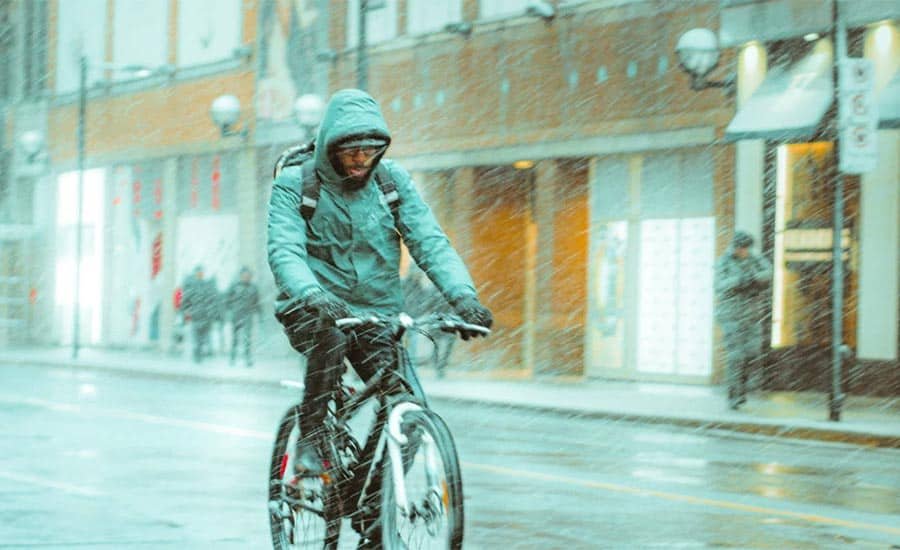Rainy days shouldn’t stop you from getting out on your trusty electric bike! But with so many e-bike owners facing this dilemma, it’s not surprising that you wonder whether it’s safe to ride in the rain.
At the end of the day, electric bikes are an environmentally friendly and convenient mode of transportation, and the last thing we want is for a bit of rain to stand in the way of our enjoying them. In this post, we’ll be your guides as we delve into the joys and challenges of riding an electric bike in the rain. From practical tips to insider knowledge, we’ll make sure you’re ready to conquer any weather that comes your way.
Can Electric Bikes Handle Rain and Wet Conditions?

Electric bikes are a game-changer for many people looking for a greener, more cost-effective mode of transportation. But with the rain pouring down and wet roads ahead, it’s natural to wonder: can these bikes handle wet conditions? The answer is yes, but with some important things to remember.
Electric bikes are built with waterproof materials, but the battery, electronics, and motor can still be vulnerable to water damage if exposed for too long.
You want to make sure your electric bike is in tip-top shape. Of course, regular maintenance is always a good idea, but it’s crucial during wet and rainy climates. Moisture can cause metal components to rust and loosen over time, so tighten joints, bolts, and nuts.
When it comes to riding in the rain, safety should be your top priority. Wet roads can be slippery, so slow down and pay extra attention to your surroundings. Visibility can also be a concern, so consider wearing bright clothing and adding lights to your bike to ensure other road users see you.
Are Ebike Batteries Waterproof
As electric bikes become more popular, many riders are concerned about how their e-bikes will handle inclement weather conditions. Of course, one of the biggest questions is whether their batteries are waterproof. So, can you safely ride your electric bike in the rain without worrying about your battery? Let’s take a closer look.
Regarding whether electric bike batteries are waterproof or not, it’s not a simple yes or no answer. Some e-bike batteries are fully sealed and rated as IP67 waterproof, meaning they can handle being submerged in water for up to 30 minutes. However, not all e-bike batteries are built to this standard, and some are only rated as IP65, meaning they are water-resistant but not completely waterproof.
It’s important to remember that even if your e-bike battery is rated as waterproof, the other components of your bike, such as the wiring and connectors, may not be. So even if your battery can handle a bit of rain, riding your e-bike in heavy downpours can cause water to seep into other areas of your bike and potentially cause damage.
So, what’s a rider to do when it rains, and they need to get around on their e-bike? The best thing you can do is to protect your battery and other components from getting wet. Invest in a waterproof cover for your bike and avoid riding in heavy rain if possible. If you must ride in the rain, dry your bike off as soon as possible to prevent water damage.
Water-resistance Ratings and Their Meanings

When purchasing electronic devices, water-resistance ratings can make all the difference. Whether buying a smartwatch while working out or a fitness tracker to wear all day, understanding these ratings is critical to ensure your device will last. With all manner of numbers and acronyms out there, it can be confusing to understand what these ratings mean. Let’s break it down.
Water-resistance ratings are determined by the International Organization for Standardization (ISO) and define the level of protection a device has against water damage. The most common ratings you’ll see are IP68, IP67, and IP66.
IP68 is the highest rating, meaning the device is entirely waterproof and can be underwater for an extended period. IP67 means the device is water-resistant and can be submerged in water for up to 30 minutes. IP66-rated electronics have enclosures that can withstand strong water jets, making them water-resistant. However, it’s important to note that this resistance is only for brief periods.
It’s important to note that just because a device has a high water-resistance rating doesn’t guarantee it will be protected from all water damage. For example, a device with an IP68 rating may still be damaged if it’s dropped in water or if water enters through the charging port or other openings.
How Do You Travel With an E-bike in the Rain (Tips for Safe E-bike Riding in the Rain)
Riding your electric bike in the rain doesn’t have to be a dreaded experience. With the right preparation and mindset, you can safely and comfortably enjoy your e-bike, even in the wettest conditions. Here’s what you can do to make the most of your e-bike in the rain:
#1. Get your e-bike ready for the rain: Check the brakes, lights, and tires to ensure everything works correctly. Equip your bike with a fender and a rack to keep you and your gear dry.
#2. Dress for success: Invest in a high-quality waterproof jacket and pants, and remember to wear a good pair of gloves to keep your hands warm and dry.
#3. Slow down and be cautious: Wet roads can be slippery, so give yourself plenty of opportunity to react to any obstacles or hazards. Keep a safe distance from other vehicles and avoid sudden stops or sharp turns.
#4. Be visible: Wear bright, reflective clothing, and make sure your bike is equipped with lights and reflectors.
#5. Plan your route wisely: Avoid busy roads and areas with heavy traffic, and look for bike paths and quieter roads to help you stay safe.
#6. Store your e-bike properly: After a ride in the rain, dry your bike and store it in a dry place to prevent rust and corrosion. Then, cover it with a waterproof cover to keep it protected and ready for your next adventure.
Should I Clean My E-bike After Riding in the Rain?

Riding your electric bike in the rain is an exhilarating experience, but it can also be messy. You might be tempted to let your bike dry on its own and clean it up later, but there are some great reasons to clean it right away.
For starters, cleaning your bike after a rainstorm will protect it from rust and corrosion. In addition, rain can leave behind all sorts of harmful substances that can cause damage over time. A quick clean will help eliminate these contaminants and keep your bike looking brand new.
Another reason to clean your bike after a rainy ride is to extend its lifespan. Dirt and debris can accumulate on your bike’s components and wear them down. Regular cleaning will help keep your bike running smoothly and keep it looking new for years to come.
And let’s remember about appearances! A dirty, wet bike isn’t exactly a show-stopper, but a clean, dry bike is sure to turn heads. Regular cleaning will also prevent staining and discoloration, so your bike will look its best for years to come.
Finally, cleaning your bike after a rainy ride is just good practice. Regular maintenance and cleaning are essential for any bike, and your e-bike is no exception.
Is It Safe to Ride an Electric Bike in a Thunderstorm
Electric bikes are becoming a popular mode of transportation for many, but when it comes to riding in a thunderstorm, people may be left wondering if it’s safe. The truth is thunderstorms can pose serious safety risks for e-bike riders.
First of all, lightning strikes are a major concern. Electric bikes are made of metal and conduct electricity, making them a prime target for lightning strikes, which can be fatal. So if you’re riding in a thunderstorm, it’s best you find shelter immediately or get off your bike and away from any metal objects.
Second, wet roads and poor visibility can make riding in a thunderstorm dangerous. Heavy rain can make the roads slippery, increasing the risk of accidents. Additionally, it can limit visibility, making it difficult to see other vehicles or obstacles on the road.
Lastly, electric bikes rely on electricity to power the motor and other components, which can be affected by water and moisture. Riding in a thunderstorm can damage the electrical system and compromise the bike’s safety.
How to Stay Safe and Dry While Riding an Electric Bike in the Rain

Riding an electric bike in the rain can be a challenging experience, but with the right gear and preparation, you can stay safe and dry while on your ride. Here are some tips to help you stay comfortable and protected while riding in the rain.
#1. Invest in the right gear: Make sure you have the right equipment to keep you dry, such as a waterproof jacket, pants, and shoes. In addition, consider getting handlebar covers or fenders to keep the rain off you and your bike.
#2. Slow down: Wet roads can be slippery, so it’s essential to slow down and take corners carefully. This will also give you more time to react to any obstacles on the road.
#3. Use lights: Visibility is reduced in the rain, so make sure your lights are turned on to make yourself more visible to other road users.
#4. Avoid puddles: Puddles can hide potholes or other road hazards, so try to avoid them as much as possible. If you have to go through one, do it slowly and carefully.
#5. Keep your bike in good condition: Regular maintenance is vital for the safety and longevity of your electric bike. Ensure the brakes, tires, and electrical components are in good working condition before your ride.
#6. Plan your route: Avoid areas prone to flooding or steep inclines. Find routes that are well-lit and have less traffic to make your ride safer.
#7. Stay alert: Pay attention to your surroundings and be prepared for sudden road conditions or weather changes.
FAQs
Can you ride an electric bike in the rain?
Riding an electric bike in the rain is possible, as these bikes are designed to withstand wet conditions. However, it’s always a good idea to take a few extra steps to stay safe and dry on your ride.
Is it safe to ride an electric bike in the rain?
Riding an electric bike in the rain is safe as long as you exercise caution and follow safety guidelines. Just remember to take it slow, make sure your lights are bright and visible, steer clear of deep puddles, and stay alert to road conditions
Can rain damage an electric bike?
Unfortunately, rain can cause damage to an electric bike if the electrical components are not adequately protected. That’s why it’s crucial to keep your bike in good condition and ensure its electrical components are waterproof.
Are electric bikes waterproof?
Electric bikes are designed to be water-resistant, but they’re not entirely waterproof. So to keep your bike protected from the elements, it’s a good idea to take extra precautions.
What should you wear when riding an electric bike in the rain?
When the skies look a little gloomy, gear up in waterproof clothing, such as a waterproof jacket, pants, and shoes. This will help keep you dry on your ride.
What precautions should you take when riding an electric bike in the rain?
When riding your electric bike in the rain, slow and steady wins the race! Also, remember to turn on your lights, watch out for puddles, and keep your bike in top shape. With these simple steps, you’ll have a safe and enjoyable ride.
